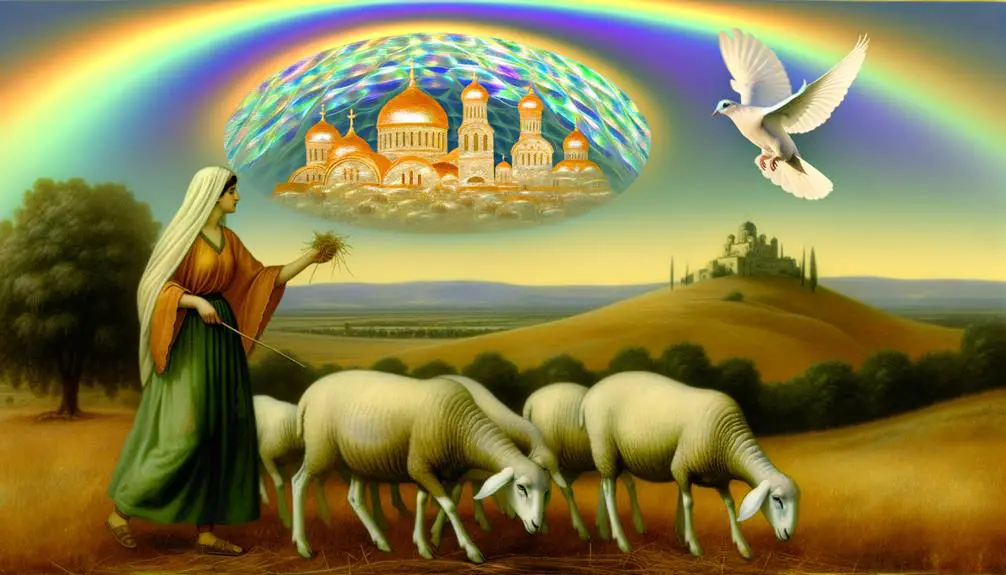Yearning for deeper spiritual insights? Discover how allegories in the Bible reveal profound truths, guiding us

Define Allegory in the Bible
In the Bible, an allegory is a storytelling technique where concrete elements symbolize deeper, often spiritual, truths. When you encounter biblical allegories, you're seeing simple narratives infused with profound spiritual importance. These stories use everyday situations and characters to reflect broader theological themes, allowing for a deeper understanding of divine truths. Allegories aren't just historical; they also offer moral and ethical guidance. By reflecting on these allegorical stories, you deepen your spiritual insights and connect more personally with the messages encoded within Scripture. Exploring these layers can greatly enrich your grasp of biblical teachings.
Key Takeaways
- Allegory in the Bible uses symbolic storytelling to convey spiritual truths and deeper meanings.
- It involves characters, events, and details that represent abstract concepts and moral lessons.
- Biblical allegories offer insights into divine intervention, moral accountability, and human behavior.
- These narratives enhance understanding by connecting concrete elements to theological ideas and principles.
- Interpretation of biblical allegories requires consideration of historical context and cultural symbolism.
Understanding Biblical Allegory

In order to grasp biblical allegory, it is important to recognize that these narratives convey deeper, spiritual truths beyond their literal interpretation. As you explore the Scriptures, you'll find that literary devices are not just decorative but serve as essential tools in conveying these profound insights. Symbolic meanings, in particular, are embedded within the texts to guide you toward a more nuanced understanding of spiritual realities.
Allegories in the Bible function by using concrete elements—characters, places, and events—as symbols to express abstract theological concepts and moral teachings. For instance, the parable of the Good Samaritan isn't just a story about helping a stranger; it's a profound commentary on the nature of neighborly love and the breaking down of societal barriers. Each element within the parable—the road, the robbers, the priest, and the Samaritan—carries symbolic weight, enriching the narrative with layers of meaning that invite you to reflect on its implications in your own life.
Understanding these allegories requires a thoughtful approach. You're invited to look beyond the surface and consider what these richly woven tales reveal about divine wisdom and human conduct. Engaging with these stories through a lens that appreciates their symbolic depth enhances your spiritual discernment and deepens your scriptural insight.
Origins of Allegory in Scripture
As you explore the origins of allegory in Scripture, you'll find that early allegorical interpretations were not merely literary devices but profound methods to convey spiritual truths. Jewish allegorical methods, in particular, reveal a rich tradition of reading beyond the literal text to unearth deeper theological and moral meanings. These approaches have shaped the way religious communities understand and articulate their beliefs, demonstrating the enduring power of allegory in biblical exegesis.
Early Allegorical Interpretations
While exploring the origins of allegory in Scripture, you'll find that early Biblical interpreters often employed allegorical methods to convey deeper, spiritual meanings hidden within the texts. This practice not only bridged ancient symbols with contemporary spiritual insights but also presented interpretative challenges. The allegorical approach allowed interpreters to navigate the complex layers of the texts, revealing richer, more profound truths.
Aspect |
Example |
Impact |
|---|---|---|
Symbols |
Tree of Life |
Represents eternal life |
Interpretation |
Serpent |
Symbolizes deceit and sin |
Text |
Garden of Eden |
Scene of mankind's fall |
Meaning |
Forbidden fruit |
Test of obedience, knowledge |
This table illustrates how elements within a narrative can hold multiple levels of significance, enriching your understanding of Biblical teachings.
Jewish Allegorical Methods
Building on early allegorical interpretations, Jewish allegorical methods further deepen our understanding of Scripture's multilayered messages. These methods, refined through centuries, reveal a profound connection between ancient wisdom and contemporary relevance. Here's how they manifest:
- Philonic Interpretations: Drawing on Hellenistic thought, Jewish philosopher Philo of Alexandria employed allegorical techniques to harmonize Jewish texts with Greek philosophy.
- Rabbinic Symbolism: Rabbis used allegory to interpret laws and narratives, infusing everyday practices with deeper spiritual significance.
- Talmudic Narratives: Stories in the Talmud often serve dual purposes—literal and allegorical, guiding moral and ethical behaviors.
- Midrashic Exegesis: This involves reading between the lines of Scripture to uncover hidden meanings and insights.
Each approach invites you to look beyond the surface, offering a richer, more textured understanding of the texts.
Key Examples of Allegory

You'll find that the Bible's parables and visions often serve as profound allegories, revealing deeper spiritual truths. Consider the Parable of the Sower, where the different types of soil represent the varied responses of hearts to God's word. Similarly, Ezekiel's vision of the Valley of Dry Bones illustrates the theme of resurrection and divine restoration in a vivid, symbolic narrative.
Parable of the Sower
In the Parable of the Sower, Jesus employs a rich allegorical narrative to reveal profound truths about the receptivity and resilience of different human hearts towards God's word. You'll see how this parable uses the allegory of seed germination and soil types to symbolize spiritual growth and readiness. Notice the depth in each type of soil:
- Pathway Soil: Represents those who hear the word but quickly lose it, as birds snatch away the seed.
- Rocky Soil: Symbolizes shallow hearts that initially respond with joy, but falter under persecution because they lack depth.
- Thorny Soil: Illustrates lives overwhelmed by worldly worries and riches, which choke the word.
- Good Soil: Shows those who hear, understand, and produce a fruitful yield, exemplifying ideal receptivity and spiritual maturity.
Each type challenges you to reflect on your own heart's condition and its openness to divine teachings.
Vineyard Owner's Tale
Another profound example of allegory in the Bible is found in the Vineyard Owner's Tale, where the vineyard symbolizes God's kingdom and the owner represents God himself. In this narrative, you're invited to ponder the meticulous care involved in grape cultivation, reflective of divine oversight and nurturing. The owner's expectations for the vineyard to produce fruit echo the ethical demands God places on His people, emphasizing harvest ethics.
This tale isn't just a story about agricultural practices but a deeper reflection on responsibility and moral accountability. As you explore this allegory, you'll see how it challenges the stewards of the vineyard—symbolizing believers—to uphold justice and faithfulness, mirroring the owner's commitment to the vineyard. The narrative implores you to reflect on your role in fostering a just and fruitful community.
Ezekiel's Valley Vision
Reflecting further on biblical allegories, Ezekiel's Valley Vision offers a profound exploration of resurrection and divine justice. This vision, found in Ezekiel 37, features the prophet standing in a valley filled with dry bones, which come to life as a symbol of Israel's restoration. Here's why this vision is significant:
- Vision Symbolism: The dry bones represent Israel's lost hope and desolation, yet promise rejuvenation and spiritual revival.
- Divine Intervention: It underscores God's power to restore life, emphasizing His ultimate control over death and life.
- Prophetic Implications: This vision forecasts the future restoration of Israel, both physically and spiritually.
- Covenant Renewal: It reaffirms God's commitment to His people, symbolizing a new covenant and a restored relationship.
Through this allegory, you're invited to see God's justice and mercy interwoven with His sovereignty.
Interpreting Allegorical Texts

To effectively interpret allegorical texts in the Bible, you must consider both the historical context and the broader theological implications. Understanding contextual symbolism, for example, is vital. The symbols used in biblical allegories aren't just random; they're deeply rooted in the cultural, religious, and socio-political milieu of the time. This means you'll need to explore the historical background of the era to grasp why certain images or characters were impactful or resonant.
Moreover, the narrative techniques employed in these texts further illuminate their meanings. Allegories in scripture often unfold through complex storytelling methods that include metaphors, parables, and symbolic characters. These narrative devices aren't just for artistic flair; they serve to encode spiritual truths that might be too profound or contentious to state directly. As you analyze these techniques, pay attention to repetition, juxtaposition, and progression in the narrative structure. These elements can reveal the emphasis and the underlying message that might not be immediately apparent.
Allegory's Role in Theology
Why do allegories hold such a pivotal role in theological discourse? You might find that allegories are not just literary devices but are essential for expressing complex theological symbolism and metaphoric doctrine in an accessible manner. They bridge the gap between divine mysteries and human understanding, allowing you to grasp profound truths that direct scriptural language might not effectively convey.
Here are four key reasons allegories are instrumental in theology:
- Enhancement of Understanding: Allegories simplify complex theological concepts, making them more relatable and easier to comprehend. This aids in deeper insight and reflection.
- Transmission of Moral Lessons: Through allegorical stories, theological teachings convey moral and ethical standards in a narrative form, encouraging a personal connection and reflection on one's life choices.
- Preservation of Doctrine: In times when direct expression might have been dangerous or misunderstood, allegories allowed for the safe communication and preservation of sensitive metaphoric doctrine.
- Engagement with the Mystical: Allegories open a window to the mystical aspects of faith, presenting theological symbolism in ways that ignite the imagination and deepen spiritual engagement.
As you explore further into theological studies, you'll appreciate how allegories serve not merely as tales, but as foundational tools in understanding and teaching the faith.
Modern Perspectives on Allegory

Having explored the traditional importance of allegory in theology, let's examine how contemporary scholars interpret these symbolic narratives. You'll find that modern perspectives on allegory aren't just about decoding ancient texts but are deeply entwined with cultural relevance and allegorical criticism. Today's scholars often focus on how these allegories resonate with or challenge current sociopolitical and ethical norms.
You might wonder, why does this matter? Well, by engaging with Biblical allegories through the lens of contemporary issues, you can uncover rich, new layers of meaning that were previously unexplored or misunderstood. This approach not only revitalizes ancient texts but also connects them to the living fabric of today's world. Think of it as a bridge between the past and the present, where ancient wisdom meets modern concerns.
Moreover, the method of allegorical criticism provides a framework for this exploration. It encourages you to contemplate not just what the text says but what it does. How does it influence, persuade, or even conflict with today's values? This critical engagement demands a balance of reverence for the traditional interpretations and openness to new insights, ensuring that Biblical allegories remain relevant and dynamic in contemporary discourse.
Frequently Asked Questions
How Do Allegories Differ From Parables in the Bible?
Exploring biblical allegories versus parables is like deciphering two ancient, intertwined vines. Allegories offer profound symbolic depth, demanding more interpretation challenges, whereas parables provide clearer, simpler moral lessons directly linked to everyday life.
Can Allegories Be Found in Every Book of the Bible?
No, allegories aren't found in every book of the Bible. Their presence varies, reflecting book-specific symbols and allegorical consistency that align with the theological and historical context of each individual biblical text.
Are There Any Risks in Misinterpreting Biblical Allegories?
Misinterpreting biblical allegories can lead to significant interpretation consequences, including cultural misunderstandings. It's important you approach these texts with a deep, scholarly reverence to grasp their intended meanings and implications accurately.
How Have Biblical Allegories Influenced Modern Literature?
Biblical allegories, with their symbolic narratives, have deeply influenced modern literature. You'll see their echoes in themes, character arcs, and moral quandaries, serving as a profound source of literary inspiration across various genres.
What Methods Do Scholars Use to Identify Allegories?
Scholars juxtapose historical context and linguistic analysis to discern allegories, meticulously comparing texts and examining language nuances. You'll find their approach deeply analytical, often revealing layers of meaning previously obscured.



Sign up